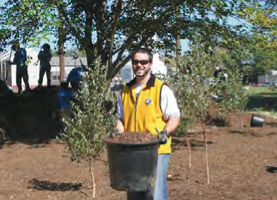Plant and Care for Trees
Urban trees have been shown to have a positive impact on the quality of streets and open space, neighborhood property value, stormwater runoff, and health of the environment
Description

Urban trees have been shown to have a positive impact on the quality of streets and open space, neighborhood property value, stormwater runoff, and health of the environment, people, and other species. Storms, age, and climate change can have a detrimental effect on urban trees, so creating a tree replacement, reforestation, or planting program is a way to ensure that your neighborhood will have a healthy tree canopy now and into the future. Programs can range from long term implementation plans to one day events for planting many trees, so choosing the best program for your neighborhood and residents is important in successful reforestation.
Related Tools
When paired with other tools, planting trees can contribute to a healthier, safer, and more sustainable neighborhood. Think about healthy streets, food resources, good public spaces, and native plants. Try combining tree planting with:
Community Projects
Add your project
Neighborhood Benefits
Environmental
- Improved air, water, and soil quality
- Reduced urban heat island effect
- Improved biodiversity and species habitat
Social
- Increased safety, walkability, and street character
- Improved local health and well-being from cleaner air, water, and soil Improved sense of place, public spaces, and ownership in community Preserved and improved character of streets, parks, and neighborhoods
- Training in gardening, planting, care, and environmental benefits of trees for local residents and youth
Economic
- Reduced energy use and utility costs
- Increased property values for individual residents and owners
Get Started
- Benefits Trees have many significant benefits for your community, your local economy, and for the environment. Urban trees improve the safety and walkability of streets, shade sidewalks and roads, reduce the urban heat island effect, and enhance plazas and parks to make them more inviting. Studies have shown that street trees increase adjacent property values, bring benefits to the homeowner, and absorb stormwater to reduce chances of flooding on your property and your street. They also absorb carbon dioxide, cool the air, and provide habitats for urban wildlife that support biological diversity.
- Various Programs There are various programs offered to residents and neighborhoods depending on the type and prospective location of your trees.
- If you are interested in planting street trees in the tree lawn - the city easement along public streets - the St. Louis Forestry Division has a Street Tree Planting Program that plants trees at no charge to the adjacent property owner. Citizens can request a street tree adjacent to their property by contacting the Citizen's Service Bureau at 314- 622-4800. Reference the Street Tree Information Bulletin.
- If you are interested in planting a tree on your personal, public, or not-for-profit property, the Missouri Urban Trees guide can also help with species selection, planting, and maintenance procedures. Trees can be obtained for free or reduced cost through organizations such as Forest Releaf of Missouri.
- If you are interested in planting fruit trees on community property, such as a community orchard, the Fruit Tree Planting Foundation has supported projects in St. Louis in the past.
- Different trees are better suited for certain locations, so make sure to choose the best kind of tree for your purpose;native trees, street trees, decorative trees, and even fruit trees can be part of your planting strategy. To get more information about the best trees to use in St. Louis, reference the Missouri Native Species guide. To learn how to plant trees, find information at arborday.org, and extension.missouri.edu.
- Establishment & Maintenance There are various methods of planting trees, and most of them require volunteers and help from other organizations, particularly with tools needed to dig, plant, and water trees. For example, you can:
- Host a one day planting event in the spring in collaboration with Arbor Day and the Arbor Day Foundation or St. Louis Earth Day. Often, fall is the best time to plant a tree.
- Create a volunteer-based ongoing program for tree planting, education, and maintenance in your neighborhood in partnership with a local organization such as Gateway Greening, Forest Releaf, Missouri Botanical Garden, Missouri Department of Conservation, St. Louis Wild Ones, Missouri 4-H, and the Open Space Council. For example, Skinker-DeBaliviere Neighborhood has a Green Committee that monitors landscaping, plants new trees, and hosts green events.
Opportunities
- Consider partnering with a citizen scientist organization to track and measure trees to ensure healthy growth and measure benefits. Create bird houses or boxes to support various species.
- Create partnerships and sponsorship programs with local businesses or organizations to incentivize volunteer planting and maintaining of trees.
Related Categories
Sustainability Plan Categories
Project Scale
- Block
- Neighborhood
- Park
- Private Site
- Public Building
- Street
Download This Tool
Plant and Care for Trees doc (413.34 KB pdf)
Need Help Viewing?
You need a program that can open Adobe PDF files. A free option:
- Adobe Reader can read PDF files
1 comment from someone like you has helped us improve this page. Keep the feedback coming!